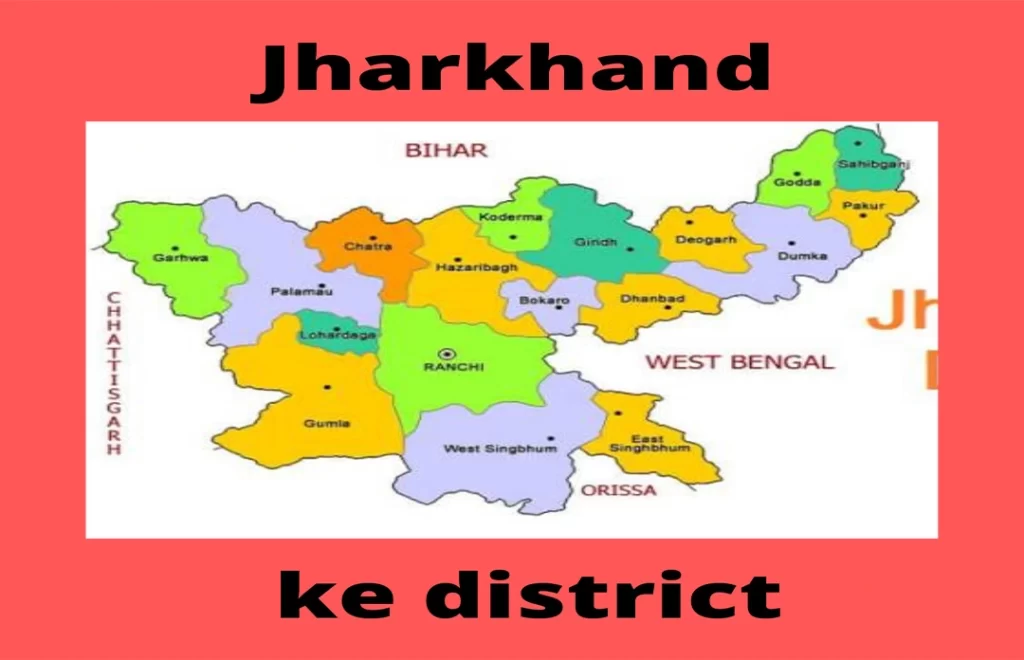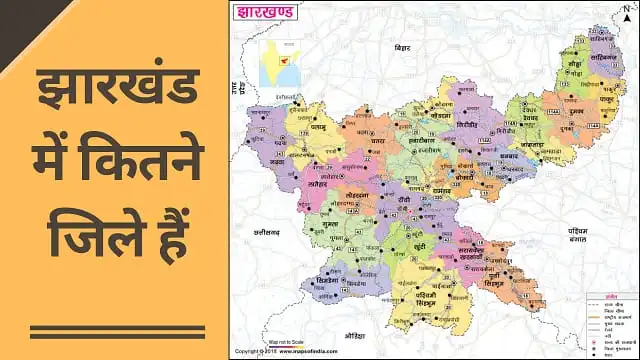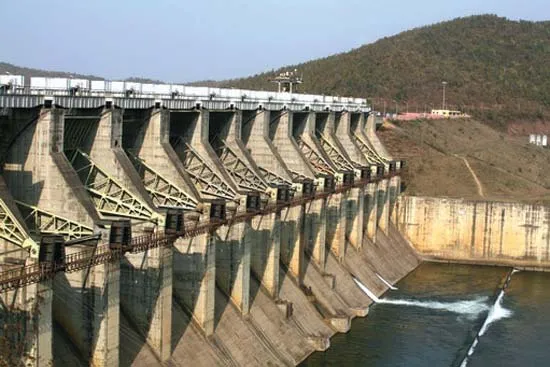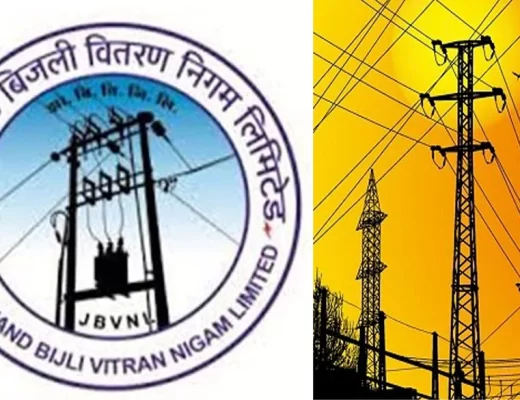How many Districts in Jharkhand: Jharkhand, a state in India, is currently divided into twenty-four districts. A district is an administrative geographical unit of an Indian state, headed by a District Magistrate or a Deputy Commissioner, an officer belonging to the Indian Administrative Service. Each district of Jharkhand is headed by a Deputy Commissioner who is in charge of the overall administration in the particular district. Ranchi, the capital of Jharkhand, is one of the oldest districts of the state. Dhanbad, Bokaro, Jamshedpur, Hazaribagh, etc. are other important cities of the state.
Jharkhand was formed with 18 districts, which were earlier part of South Bihar, on 15 November 2000. Some of these districts were reorganized to form 6 new districts, Khunti is the newly formed 24th district of Jharkhand, which came into existence. September 2007
Also, Read- Netarhat Jharkhand, Origin और History, Chotanagpur की रानी (Netarghat) कैसे पहुँच सकते हैं?… Read More
In Hindi:
झारखंड, भारत का एक राज्य, वर्तमान में चौबीस जिलों में विभाजित है। एक जिला एक भारतीय राज्य की एक प्रशासनिक भौगोलिक इकाई है, जिसका नेतृत्व एक जिला मजिस्ट्रेट या एक उपायुक्त, भारतीय प्रशासनिक सेवा से संबंधित एक अधिकारी करता है। झारखंड के प्रत्येक जिले का नेतृत्व एक उपायुक्त करता है जो विशेष जिले में समग्र प्रशासन का प्रभारी होता है। झारखंड की राजधानी रांची राज्य के सबसे पुराने जिलों में से एक है। धनबाद, बोकारो, जमशेदपुर, हजारीबाग आदि राज्य के अन्य महत्वपूर्ण शहर हैं।
झारखंड का गठन 18 जिलों के साथ किया गया था, जो पहले दक्षिण बिहार का हिस्सा थे, 15 नवंबर 2000 को। इनमें से कुछ जिलों को 6 नए जिलों के रूप में पुनर्गठित किया गया था, जो खूंटी झारखंड का नवगठित 24वां जिला है, जो अस्तित्व में आया। सितंबर 2007
Districts of Jharkhand
Jharkhand has 24 districts: They are- Ranchi, Lohardaga, Gumla, Simdega, Palamu, Latehar, Garhwa, West Singhbhum, Seraikela-Kharsawan, East Singhbhum, Dumka, Jamtara, Sahebganj, Pakur, Godda, Hazaribagh, Chatra, Koderma, Giridih, Dhanbad, Bokaro, Deoghar, Khunti, and Ramgarh.
Geography of Jharkhand
Geography of Jharkhand Jharkhand is located in the eastern part of India bordering the states of Bihar, West Bengal, Orissa, and Chhattisgarh. The Tropic of Cancer passes through Kanke, a few kilometers from Ranchi, the capital of Jharkhand, making it the only state in India that touches the Tropic of Cancer. Most of the Jharkhand region is part of the Chhotanagpur Plateau, which extends to parts of West Bengal, Chhattisgarh, and Orissa. The area is composed of ancient Arquaian granite Tatanis stone.
झारखंड का भूगोल झारखंड भारत के पूर्वी भाग में बिहार, पश्चिम बंगाल, उड़ीसा और छत्तीसगढ़ राज्यों की सीमा में स्थित है। कर्क रेखा झारखंड की राजधानी रांची से कुछ किलोमीटर की दूरी पर कांके से होकर गुजरती है, जिससे यह भारत का एकमात्र राज्य है जो कर्क रेखा को छूता है। झारखंड क्षेत्र का अधिकांश हिस्सा छोटानागपुर पठार का हिस्सा है, जो पश्चिम बंगाल, छत्तीसगढ़ और उड़ीसा के कुछ हिस्सों तक फैला हुआ है। यह क्षेत्र प्राचीन आर्कियन ग्रेनाइट टाटानिस पत्थर से बना है।
Economy of Jharkhand
The economy of Jharkhand Born out of the bifurcation of the old Bihar state in 2000, Jharkhand produces about 40% of the output of the old Bihar state. Being rich in minerals, the state is one of the most industrialized regions of the country today. The region contains 35.5% of the country’s known coal reserves, 90% of its cooking coal reserves, 40% of its copper, 22% of its iron ore, 90% of its mica, and deposits of bauxite, quartz, and porcelain. There are huge stores. It is home to the largest steel plant in Bokaro. Apart from Jamshedpur practically being the city of TISCO and TELCO.
There are other important companies like HEC in Ranchi and MECON in Ranchi, which are contributing to the development of the state. Agriculture has never been the mainstay of the economy in the region of Jharkhand, but about 80% of the population in this mineral-rich state is dependent on agriculture. Rice is the major crop of the state with pulses and wheat being the others. The state is focusing on increasing the land under cultivation, developing irrigation facilities, and developing agriculture-related businesses.

झारखंड की अर्थव्यवस्था
झारखंड की अर्थव्यवस्था 2000 में पुराने बिहार राज्य के विभाजन से पैदा हुई, झारखंड पुराने बिहार राज्य के उत्पादन का लगभग 40% उत्पादन करता है। खनिजों से समृद्ध राज्य आज देश के सबसे औद्योगिक क्षेत्रों में से एक है। इस क्षेत्र में देश के ज्ञात कोयले के भंडार का 35.5%, इसके खाना पकाने के कोयले के भंडार का 90%, इसके तांबे का 40%, इसके लौह अयस्क का 22%, इसके अभ्रक का 90% और बॉक्साइट, क्वार्ट्ज और चीनी मिट्टी के बरतन के भंडार हैं। बड़े भंडार हैं।
जमशेदपुर व्यावहारिक रूप से टिस्को और टेल्को का शहर होने के अलावा बोकारो में सबसे बड़ा इस्पात संयंत्र है। रांची में एचईसी और रांची में मेकॉन जैसी अन्य महत्वपूर्ण कंपनियां हैं, जो राज्य के विकास में योगदान दे रही हैं। झारखंड के क्षेत्र में कृषि कभी भी अर्थव्यवस्था का मुख्य आधार नहीं रही है, लेकिन इस खनिज संपन्न राज्य में लगभग 80% आबादी कृषि पर निर्भर है। चावल राज्य की प्रमुख फसल है जिसमें दालें और गेहूँ अन्य हैं। राज्य खेती के तहत भूमि बढ़ाने, सिंचाई सुविधाओं के विकास और कृषि से संबंधित व्यवसायों को विकसित करने पर ध्यान केंद्रित कर रहा है।

Jharkhand Travel Information
The state capital Ranchi still has its old-world colonial charm. On the outskirts of Ranchi is the famous Tagore Hill, named after Rabindranath Tagore. Who is believed to have written a part of his famous Gitanjali here, among other poems? At the other end of Ranchi is the Kanke Dam, which is always full of tourists. A few kilometers from the dam is the 17th-century Jagannath Temple. Where the annual Rath Yatra is held in the month of June/July. On the Ranchi – Hazaribagh road is the War Cemetery, the smallest ‘density’ cemetery in India with a total of 708 graves. Including a soldier from the army of undivided India and many other countrymen who fought for the British cause. The tombs are well-classified and all of them are worth noting for their attractive epitaphs. McCluskeyganj is a small village near Ranch.
It evokes nostalgia and slowly it is revealed that the place was once popular with the Anglo-Indian community. The filmmakers have not only taken care of the spectacular scenic beauty, clean air, and extraordinary greenery. But have also taken care of the village itself, which is a heady mix of untamed and refined. Some of the houses here have retained their English names with the inscription ‘Haunted House’. During the 1950s, there were no less than 100 Anglo-Indian families with their distinctive cottages, clubs, and shops. There are many other places of interest like Betla National Park (Palamu), Hazaribagh Wildlife Sanctuary, Netarhat, Rajrappa, Parasnath, and Deoghar.
Jharkhand food
Rice is the most important part of any meal in Jharkhand. While pulses and vegetables add a lot of value to it. Bread is usually taken with lentils and vegetables at dinnertime. The tribal population makes their own local brew, Hanriya, which is made from rice and has a strong odor. Initially, the tribes of this region were more into hunting and wild animals. But nowadays most of them are into agriculture and hunting is limited to a very small part of the population.
चावल झारखंड में किसी भी भोजन का सबसे महत्वपूर्ण हिस्सा है, जबकि दालें और सब्जियां इसमें बहुत अधिक मूल्य जोड़ती हैं। रात के खाने में आमतौर पर रोटी दाल और सब्जी के साथ ली जाती है। आदिवासी आबादी अपना स्थानीय काढ़ा, हनिया बनाती है, जो चावल से बनाया जाता है और इसमें तेज गंध होती है। प्रारंभ में, इस क्षेत्र की जनजातियाँ शिकार और जंगली जानवरों में अधिक थीं, लेकिन आजकल उनमें से अधिकांश कृषि में हैं और शिकार आबादी के बहुत छोटे हिस्से तक सीमित है।
Art and Culture of Jharkhand
Jharkhand is home to many tribes. They differ significantly not only from non-tribal populations but also from each other. The most ancient of them are the Mundas, while the Santhals were the last tribes to settle in Jharkhand. Unlike the dark brown or almost black complexion of most tribals. The Cheros are light brown in complexion and have Dravidian physiognomy. As they appear to have migrated from the sub-Himalayan tract. Other tribes are Hos, Oraon, Kariya, Birhor, Sauriya, Paharia, Mal Paharia, Birjia, Asur, Bhumij etc.
The tribal society of Jharkhand has a rich tradition of arts and crafts. It is clearly visible in the rock paintings of the region which are more than 5000 years old. The best place to experience the art and craft traditions of this state is the Tribal Research Institute and Museum in Ranchi. The tribes of Jharkhand specialize in making plates by gluing sal leaves to small sticks. You can also taste local brews like Mahua and Hanaria that flow like water in the region.

Also, Read- Bhulekh Jharkhand, Highlights of Jharbhumi, How to Che…Read More.
FAQs on How many Districts in Jharkhand
Which is the largest district of Jharkhand?
Ranchi is the largest district of Jharkhand by population, while Lohardaga is the least populated district of Jharkhand.
What is the old name of Jharkhand?
Later, during the Mughal period, the Jharkhand region was known as Kukra. After the year 1765, it came under the control of the British Empire and formally came to be known under its current title “Jharkhand” – the land of “Jungles” (forests) and “Jhaadis” (bushes).
What is Jharkhand most famous for?
There are many famous places to see in Jharkhand which include many waterfalls. Jamshedpur, Rajmahal hills, Parasnath, Bokaro steel city, famous coal mines, Netarhat, etc.
What is Jharkhand famous for?
Jharkhand is famous for its rich mineral resources like uranium, mica, bauxite, granite, gold, silver, graphite, magnetite, dolomite, fireclay, quartz, feldspar, coal (32% of India), iron, copper (25% of India) Is. Etcetera. Forests and woodlands occupy more than 29% of the state which is the highest in India.
Suggested Link:- National Scholarship Portal
@Ron



